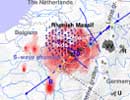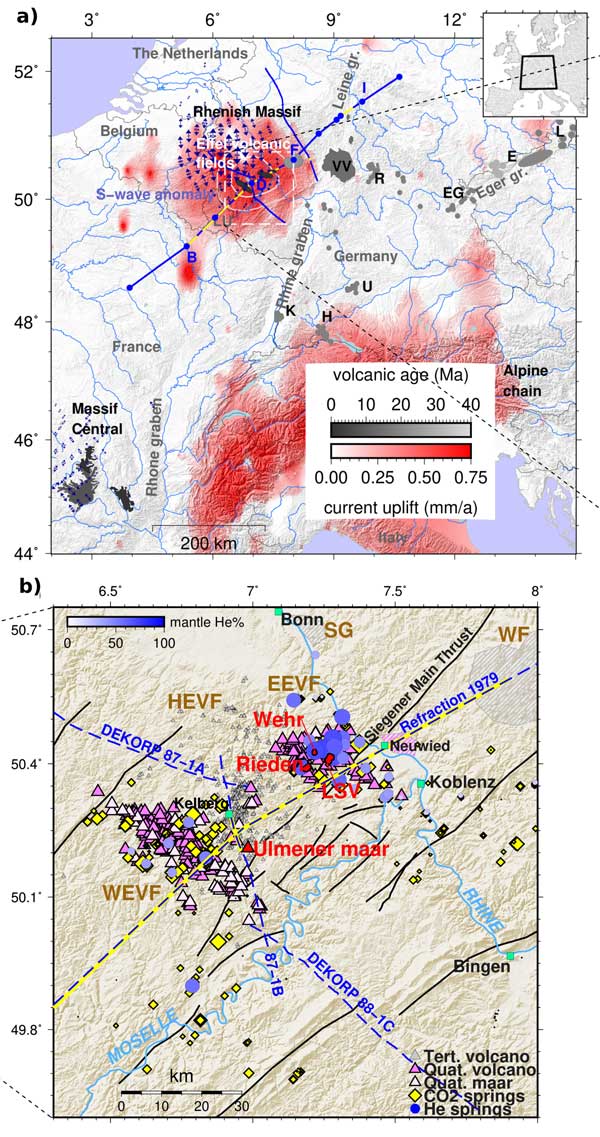 |
Signatures of the deep crustal magma systems of the Cenozoic volcanic fields beneath the Eifel, Germany – a review |
Torsten Dahm
GFZ German Research Centre for Geosciences, Potsdam, Germany, torsten.dahm@gfz-potsdam.de
This webpage is a summary of: Dahm, T., M. Stiller, J. Mechie, S. Heimann, M. Hensch, H. Woith, B. Schmidt, G. Gabriel, and M. Weber (2020), Seismological and Geophysical Signatures of the Deep Crustal Magma Systems of the Cenozoic Volcanic Fields Beneath the Eifel, Germany, Geochemistry, Geophysics, Geosystems, 21, e2020GC009062.
Introduction
Monitoring of magma ascent, accumulation and reservoir unrest is challenging and has only been possible in exceptional cases. Therefore, we still understand only poorly the chemical and physical interactions between magmatic fluids and wall rock, the complex pathways of fluid ascent, and how broad regions of partial melting at mantle depths link up with localized volcanic eruption centers at the surface. The Eifel volcanic fields in West Germany comprise many hundreds of maars and cinder cones, as well as three larger, explosive volcanic centers. The most recent volcanic maar eruption in the Eifel was as recent as ~11,000 BP and the last Plinian VEI 6 eruption at the Laacher See volcano (LSV) ~13,000 BP. The Eifel is the only site in Central Europe where recent discoveries have provided evidence for upward movement of fluids causing deep low frequency earthquakes (Hensch et al., 2019) along with uplift over a broad zone with a diameter of ~200 km (Kreemer et al., 2020). Emission of magmatic gases and subrecent volcanism are further indications that the deep parts of this system remain in a state of unrest. Recent studies of the Laacher See volcano (LSV) centre have also shown that long-lived crystal-mush reservoirs persisted many thousands of years prior to its cataclysmic eruption (e.g., Schmitt et al., 2010, Rout & Wörner, 2018; 2020).

Figure 1: (a) Central European Cenozoic volcanic fields plotted together with ongoing uplift and crustal extension (data from Kreemer et al., 2020). Upper mantle shear wave anomalies beneath the Eifel (Keyser et al., 2002) are indicated by white isolines. Abbreviations of volcanic fields are: VV=Vogelsberg, R=Rhön, EG=Eger graben, E=Erzgebirge, L=Lausitz, U=Urach, H=Hegau, K=Kaiserstuhl). Refraction (from 1979, letters indicate shot points) and reflection seismic profiles (DEKROP87/88) are plotted as blue lines. Dashed yellow segments indicate sections affected by Moho-level P-wave anomalies. (b) Eifel volcanic fields including the Quaternary West (WEVF), East Eifel volcanic fields (EEVF) and Tertiary volcanic fields (HEVF=Hocheifel, WF=Westerwald, grey symbols and field, see also legend). Explosive centres (Laacher See volcano=LSV, Wehr, and Rieden) are indicated by red polygons. The youngest maar in the WEVF (Ulmener maar) is highlighted by a red triangle; emission points for mantle-derived CO2 (yellow diamonds) and He (blue circles) are shown along with major faults (black lines).
Our paper arose from the reprocessing and re-visiting of reflection and refraction seismic profiles from 1978-1979 and 1987-1988 crossing the Eifel volcanic fields, together with the recent findings of geodyamic and volcanic unrest in the East Eifel region. Hensch et al. (2019) report persistent clusters of deep low frequency earthquakes (DLF) beneath the LSV forming a channel-like structure from 43 km to ~8 km depth just beneath the LSV. A recent paper by Kreemer et al. (2020) documented that the Eifel is the only region in Central Europe, apart from the Alpine chain, experiencing significant ongoing uplift together with crustal extension (Figure 1).
Our re-analysis of the refraction and reflection seismic data from West Eifel confirms a transparent zone in the lower crust above a low velocity layer in the upper mantle, which is interpreted as a possible hot zone. At the top of the transparent zone a bright spot is seen in seismic images, which is interpreted as a cooled magma chamber. We question whether the same type of reservoir is currently being re-filled in the Eastern Eifel, where the DLF earthquakes align on a channel-like structure connecting the mantle reservoir with the upper crust to about 8 km. The refraction seismic data indicate a prominent 5-6 km thick low-velocity gradient layer at and below the Moho, along a structural zone of weakness and a Moho step extending > 120 km. If this layer is caused by partial melt, the melt content from the bottom of the layer to the Moho increases from 0 to about 10%. The lower crust above the low-velocity gradient layer has unusually low P-wave velocities of only 6.25 km/s, which may represent anhydrous felsic rocks at high temperature or mafic igneous rocks of the lower crust with ≈3% partial melt. The Moho depth indicates a small upwelling, and the reduction in velocity in the lower crust is greatest where the Moho is shallowest. Our paper discusses these and other findings in context of other geophysical and geochemical data and current views of crustal magmatic reservoirs.
These findings confirm the model of upper mantle upwelling below the Eifel volcanic fields. Whether this upwelling has deeper roots in the mantle cannot be determined and was not studied. However, our results fit smoothly with the concepts of anorogenic plateau formation developed by Duesterhoeft et al. (2012), Li & Li (2007) and Axen et al. (2018), and anorogenic alkaline volcanism and Cenozoic magmatism within Europe to the north of the Alpine collision zone (e.g., Wilson & Downes, 2006). According to Wilson & Downes (2006), the east-west elongated terrane boundaries of micro-continent collisions during the Variscan form regions of anomalously thin, irregular or weak lithosphere and have exerted a significant control on the location of subsequent Cenozoic magmatism. They act as pathways for magma ascent through the lithosphere. Independent of the details of the processes leading to partial melting in the asthenosphere, Variscan structural fabric has controlled the locations of the Tertiary and Quaternary volcanism in the Eifel and the Rhenish Massif.
References
-
Axen, G.J., van Wijk, J.W., Currie, C.A. (2018). Basal continental mantle lithosphere displaced by flat-slab subduction. Nature Geoscience, 11, 961-964. 10.1038/s41561-018-0263-9
-
Duesterhoeft, E., Bousquet, R., Wichura, H., Oberhänsli R. (2012). Anorogenic plateau formation: The importance of density changes in the lithosphere. J. Geophys. Res., 117, B07204. doi:10.1029/2011JB009007
-
Hensch, M., Dahm, T., Ritter, J., Heimann, S., Schmidt, B., Stange, S., Lehmann, K. (2019). Deep low-frequency earthquakes reveal ongoing magmatic recharge beneath Laacher See Volcano (Eifel, Germany), Geophys. J. Int., 216(3), 2025-2036. 10.1093/gji/ggy532
-
Kreemer, C., Blewitt, G., Davis, P.M. (2020). Geodetic evidence for a buoyant mantle plume beneath the Eifel volcanic area, NW Europe. Geophys. J. Int., 222(2), 1316–1332. https://doi.org/10.10 93/gji/ggaa227
-
Li, Z.X. & Li, X.H. (2007). Formation of the 1300-km-wide intracontinental orogen and postorogenic magmatic province in Mesozoic South China: A flat subduction model. Geology, 35, 179-182, 10.1130/G23193A.1.
-
Rout, S.S.; Wörner, G. (2018). Zoning and exsolution in alkali feldspars from the Laacher See volcano (Western Germany): constraints on temperature history prior to eruption. Contr. Mineral. and Petrol. 173:95, 10.1007/s00410-018-1522-x
-
Rout, S. S.; Wörner, G. (2020) Constraints on the pre-eruptive magmatic history of the Quaternary Laacher See volcano (Germany). Contr. Mineral. and Petrol. 175:73, 10.1007/s00410-020-01710-3
-
Schmitt A.K., Wetzel F., Cooper K.M., Zou H.B., Wörner G. (2010). Magmatic longevity of Laacher See Volcano (Eifel, Germany) indicated by intrusive carbonatites. J. Pet., 50, 1053-108
-
Wilson, M.; Downes, H. (2006). Tertiary-Quaternary intra-plate volcanism in Europe and its relationship to mantle dynamics. In: Gee, D.G., Stephenspn, R.A. (eds): European Lithosphere Dynamics. Geological Society, London, Memoirs, 32, 147-166, 0435-4052/06
last updated 20th November, 2020 |
